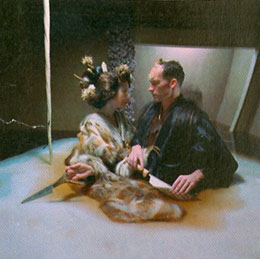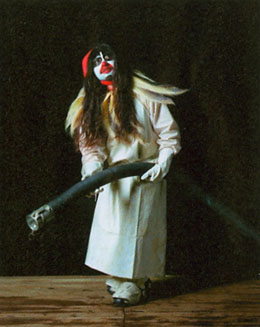DRAWING RESTRAINT #9 MATTHEW BARNEY, DIRECTOR IFC Films, 2006
MATTHEW BARNEY SEES his latest film extravaganza, Drawing Restraint #9, as a model of a world that contains an entire universe within each of its parts. Shot in the environs of Nagasaki Bay in Japan, Drawing Restraint #9 (DR #9) is a love story that stars two so-called “Occidental Guests” played by Barney and his partner, the Icelandic avantpop star Björk, who also composed the film’s ethereal soundtrack. The pair meet on board the Nisshin Maru, the world’s only active whale factory ship, and, through a series of unexpected collisions with Japanese cultural traditions, transform into whales. The film also tracks the fabrication and decay of a forty-five-thousand-pound petroleum jelly sculpture, and, as the plot unfolds, the two narratives merge to reveal Barney’s underlying vision of universal interconnectedness.
Barney, born in 1967, completed the first six Drawing Restraint projects as an undergraduate at Yale, where he went to play football and study premed. (He wanted to be a plastic surgeon.) He transferred instead to the fine arts department, where he started making art about hypertrophy—the break-them-down-to-build-them-up process that muscles go through during weight resistance training. In the first Drawing Restraint project, he tethered himself to a harness attached to elastic bands and strained against them while running up a ramp to make drawings on a wall. In the sixth, he jumped on a small inclined trampoline and made a self-portrait on the ceiling, one mark per jump. The idea that form, and therefore creativity, emerges through struggle against restraint became and remains central to Barney’s oeuvre.

In the Cremaster Cycle (1993-2002), the five-part filmic visual opera that garnered Barney a place in art history’s pantheon, Barney stars as a hero subject to extraordinary obstacles in the journey toward sexual self-definition—a voyage symbolically represented by Barney’s heraldic symbol, the field emblem, which is a lozenge-shaped oval bisected by a bar. To Barney, the oval signals the body’s completeness, while the bar symbolizes the restraints that allow creative form to emerge. In the Cremaster films, the bar always remains in place. In Drawing Restraint #8(2003), however, Barney removes the bar in order to activate an erotic gesture. DR #8 is a series of drawings including images of an erect penis shooting sperm into a Milky Way-like sky, an abstract rendition of a couple coupling, and pictures of the field emblem with the restraint removed, its two sides collapsing in on each other. In DR #8, then, instead of a singular hero trying against all odds to make its way in the world, two separate entities are united.
To Barney, removing the restraint in DR #9 allows it to become a love story, not only between its protagonists but also between his personal mythology and the cultural traditions of Japan. (DR #9 was originally commissioned by the 21st Century Museum of Contemporary Art in Kanazawa, Japan, to be part of the Drawing Restraint retrospective, now on view at the San Francisco Museum of Modern Art through September 17.) Being a guest in Japan became the initial psychological restraint to overcome, which Barney handles in the film by introducing the quintessential Japanese-American love story—that between the Japanese and General Douglas MacArthur. Opening scenes feature a Japanese woman ceremoniously wrapping two halves of an ancient fossil in wedding paper. The accompanying song, its lyrics in the form of a letter, tells viewers that the fossil is a gift from a Japanese fisherman to General Douglas MacArthur, thanking him for removing the moratorium on whaling as head of the American occupation of Japan after World War II. Many Japanese worshiped MacArthur for abolishing the emperor system, instituting democracy, and lifting the whaling moratorium, which had been causing widespread starvation in Japan’s coastal cities and villages. When the woman finishes wrapping the gift, she seals it with a golden sticker in the form of the field emblem, from which she peels away the bar. This act—a surprising marriage between two parties that would seem more likely to be enemies—sets the story in motion.
Soon, a subtle and unexpected symmetry between Barney’s artistic idiom and the Japanese Shinto whaling tradition begins to emerge. Petroleum jelly, a byproduct of oil drilling that was discovered when oil replaced whale blubber as a primary energy source, has always been a key material for Barney. In Cremaster 4 (1994), he squeezed through a spinal column-

like tunnel greased with it. In Cremaster 3 (2002), he had the sculptor Richard Serra throw molten scoops of it at walls of the Guggenheim Museum. Early scenes in DR #9 feature Shinto dancers performing the Awa Odori festival’s “dance of fools,” a dance traditionally used to welcome ancestors home. The dancers pull an oil truck through the middle of an oil refinery to the dock beside the Nisshin Maru. Instead of delivering oil, however, the truck pumps forty-five thousand pounds of liquid petroleum jelly into a mold on the deck of the Nisshin Maru that is shaped like a field emblem and incised on the sides to resemble whale skin. Japanese who practice Shinto see whales as both a source of energy and as their ancestors. To Barney, petroleum jelly—a byproduct of oil, which itself derives from ancient fossils—is similarly primordial. So this common substance, with the very practical application of relieving friction between two opposing parts, is the symbolic grease that allows the seemingly incompatible elements of the DR #9 universe to mesh with one another.
ALL THIS IS NOT TO SAY that the merger will be without its drama. After the guests are brought from shore to the Nisshin Maru, they pass under the ship’s masts, which are the shape of torii, the sacred gate of a Shinto shrine. They are then brought below deck, where they undergo ritual purification. Barney falls asleep and has his head shaved beneath a Japanese screen painted with whaling scenes; Björk bathes in an industrial tub filled with lemons and has her face painted like a geisha and her teeth painted black. Both are then ceremoniously dressed in Shinto-style wedding robes, specially designed by Barney out of animal skins rather than traditional silk. They wind their way through the ship’s industrial-looking hallways until they are brought together for a traditional koicha (thick tea) ceremony, inside a perfectly appointed tearoom.
While the guests engage in the carefully prescribed rituals of the tea ceremony below deck, the Nisshin Maru crew become seduced by Barney’s symbolic game through contact with his sculpture, which they begin to handle like a whale. The jelly has congealed through exposure to the cool sea air, making it possible for the men to remove its middle section (i.e., the bar of the field emblem) with a giant crane. Meanwhile, a giant piece of ambergris, another Barney sculpture, is harpooned and brought on board, where it is anointed with sake. The crew then threads this ambergris through the sculpture’s now vacant center and removes the rest of the mold. As the huge petroleum jelly form starts to collapse, they pierce it with flensing knives as if it were a whale. The field emblem, the very crux of Barney’s symbolic language, has turned Japanese.
Suddenly, a lightning storm brews and the tearoom below deck floods with liquified petroleum jelly—a sort of amniotic fluid. The carefully ordered universe of DR #9 is disintegrating, and like the two halves of the now atrophying sculpture, the two guests find themselves thrown together in an erotic embrace. Soon they are waist deep in liquid and go after each other with flensing knives, amputating each other’s legs. As they do, viewers discover that the guests’ bodies are not human flesh but whale blubber. Blowholes form at the base of their necks. The guests have transformed into the ancestors of their hosts—they are now whales.
DR #9 starts off with two separate bodies—the Guest and the Host—coming into contact with one another as strangers. Through Barney’s poetic machinations, the two become the same flesh and blood, and we come to realize that DR #9 is essentially a grand diplomatic gesture, imploring us to explore beneath the surface of cultural differences to find the point where we all become part of the same whole.